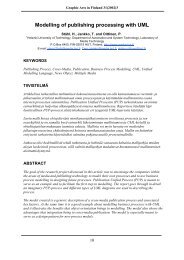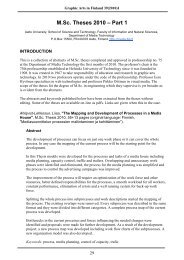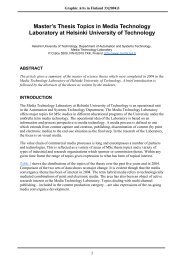Client-Side Storage in Web Applications
Client-Side Storage in Web Applications
Client-Side Storage in Web Applications
Create successful ePaper yourself
Turn your PDF publications into a flip-book with our unique Google optimized e-Paper software.
Table 3. Browser support for <strong>Web</strong> SQL Database.Chrome Firefox IE Opera Safari Android iOS Safari4.0+ — — 10.5+ 3.1+ 2.1+ 3.2+3.3 Indexed Database APIIndexed Database API 6 or simply IndexedDB [17] is the newest and most sophisticatedof the three client-side storage APIs. It offers a robust mechanism for stor<strong>in</strong>gand manag<strong>in</strong>g persistent (long-lived), advanced key-value pair data through the use ofJavaScript APIs. Due to its advanced data management features, IndexedDB can bethought of as a comb<strong>in</strong>ed and upgraded version of <strong>Web</strong> <strong>Storage</strong> and <strong>Web</strong> SQL Database.IndexedDB is a NoSQL database (similar to MongoDB 7 and Apache CouchDB 8 ),mean<strong>in</strong>g it stores data <strong>in</strong> schemaless object stores <strong>in</strong>stead of fixed-schema relationaltables, as is the case <strong>in</strong> <strong>Web</strong> SQL Database [15]. The type of data that can be stored <strong>in</strong>object stores varies from primitive data types (e.g., str<strong>in</strong>g, array, and date) to hierarchicalobjects (e.g., JavaScript Object Notation, JSON). Support<strong>in</strong>g the JSON formatnatively is a huge advantage, because then there is no need to map the data betweendifferent data models and the problem of impedance mismatch can be completelyavoided. The storage space available is also bigger than <strong>in</strong> other client-side storageoptions. For example, Firefox defaults to 50 MB per orig<strong>in</strong> and the space can be <strong>in</strong>creasedupon request. Other its advantages <strong>in</strong>clude: (1) duplicate values for a key, (2)the utilization of <strong>in</strong>dexes for efficient searches, (3) support for transactions and callbacks,and (4) both synchronous (may be removed <strong>in</strong> the future) and asynchronousdatabase APIs. The disadvantage of the API lies <strong>in</strong> its complexity. Luckily, there areseveral wrappers over IndexedDB available, such as jQuery IndexedDB plug<strong>in</strong> 9 .List<strong>in</strong>g 3 demonstrates the usage of Indexed Database API as is without a wrapper.First, variables and data are def<strong>in</strong>ed (cf. l<strong>in</strong>es 1-8). Next, a database is created/opened,after which it is <strong>in</strong>itialized if needed, i.e., an object store is created and <strong>in</strong>itial data(JSON) is stored <strong>in</strong> the object store (cf. l<strong>in</strong>es 10-29). F<strong>in</strong>ally, the data is retrievedfrom the object store and the database connection is closed (cf. l<strong>in</strong>es 31-42).1: // Def<strong>in</strong>e variables2: var myDatabase = null;3: var version = 1;4: // Def<strong>in</strong>e data5: var myData = {6 Also referred to as IndexedDB and <strong>Web</strong>SimpleDB API.7 MongoDB, http://www.mongodb.org/8 Apache CouchDB, http://couchdb.apache.org/9 jQuery IndexedDB plug<strong>in</strong>, http://nparashuram.com/jquery-<strong>in</strong>dexeddb/8
















